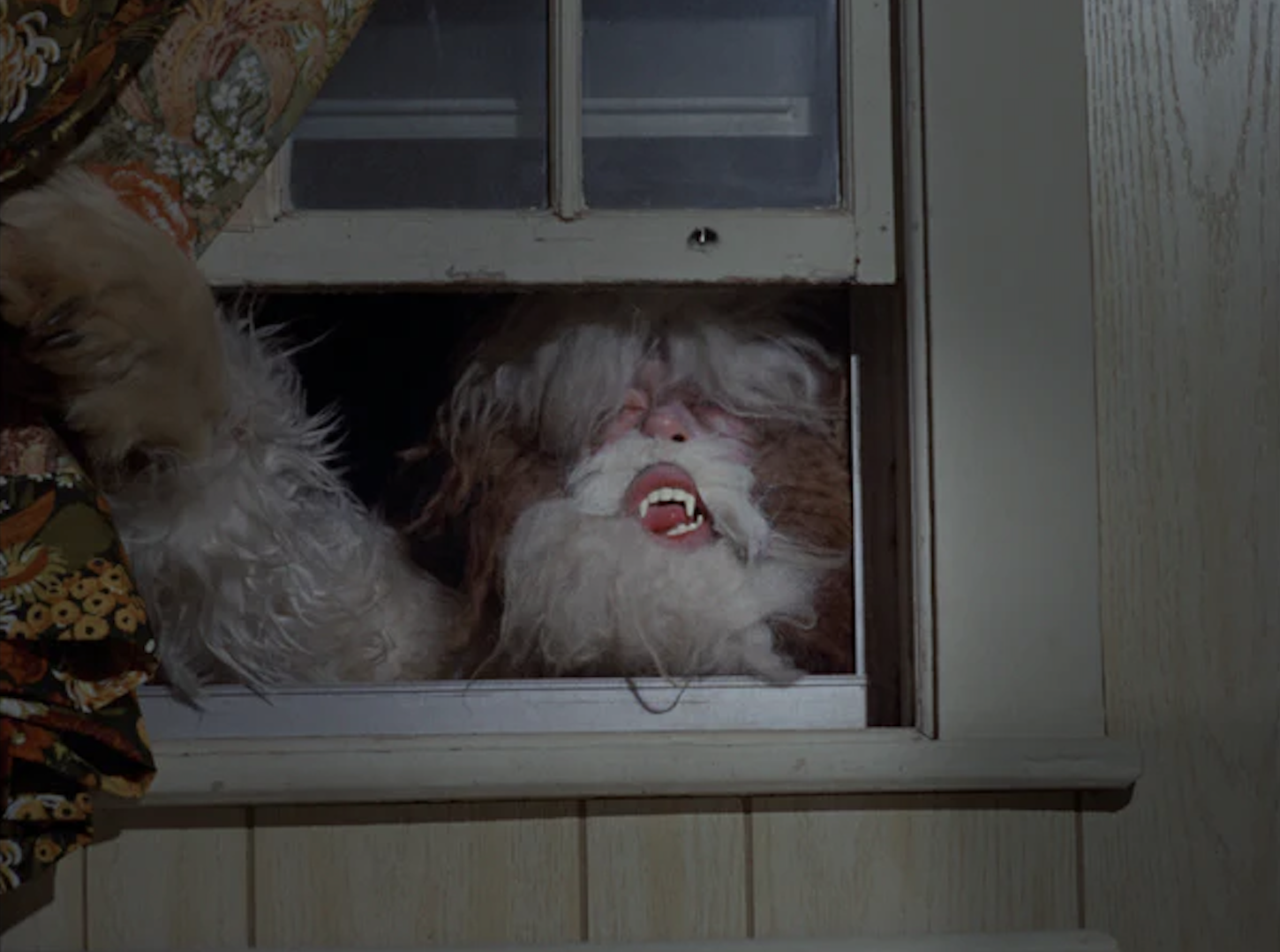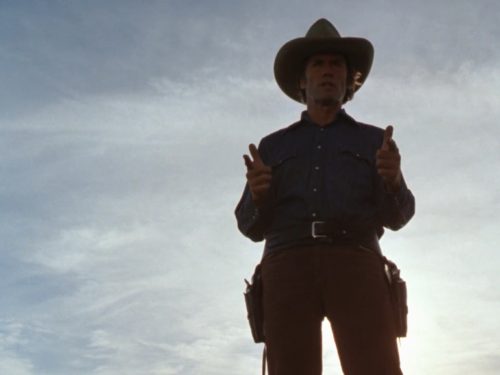Often referred to — heralded by some — as one of the worst films ever made, the yeti-in-upstate-New-York exploitation classic is a unique oddity born from a meeting of wildly disparate filmmaking sensibilities
Produced in the heyday of grindhouse cinema, Shriek of the Mutilated (1974) throws everything at the wall: An Abominable Snowman in upstate New York, a cannibal cult, a Scooby-less gang of Mystery Team clones, coeds using classmates as woodland booby-trap bait, a near death by fork-stabbing, and even a bathtub toaster murder. It is a film that is nearly wall-to-wall dialogue, but some attention-stealing oddity always manages to sneak in amongst the chatter. Take, for instance, an early college party scene with enough room to include a threatening monologue from a traumatized ex-scholar-turned-greenskeeper and a carnival barker selling freshly popped popcorn — set to the tune of a song called “Popcorn” by Hot Butter. Some of these many elements stick, but the stuff that doesn’t quite hold to the wall is scraped up and used anyway. After all, all’s fair in love and schlock!
Shriek of the Mutilated is at once rough and innocent — rough in its texture, and innocent in the way it goes for broke despite its obvious limitations. It’s the kind of movie that feels like characters are killed off only because the actors were needed elsewhere on set. This is, of course, not a criticism. It instead, to me at least, suggests a type of energy that is almost extinct in movie making these days. You can sense the scrounging that took place to pull together the production, during which the strange and disparate sensibilities of each collaborator were forced to clash and blend into a finished product.
The film is about a group of four students who follow their professor, Dr. Prell (Alan Brock), into the woods to track down a mythical yeti creature. Included is Keith (Michael Harris) — Prell’s star student who is invited to dine with his mentor at a “specialty restaurant” where they eat from the secret menu — and his girlfriend, Karen (Jennifer Stock), the only one sharp enough to recognize that something isn’t quite right with the expedition. The night before their field trip, most of the students attend a party where they encounter Spencer Ste. Claire (Tom Grail), the aforementioned greenskeeper who was a former student of Prell’s. After a few drinks, he warns the students not to trust Dr. Prell. He erupts into a fit over how he barely survived the last expedition — seven years ago to the day — during which he lost three friends and went mad after a face-to-face encounter with the yeti. The Ste. Claires leave the party, go home, and murder each other.
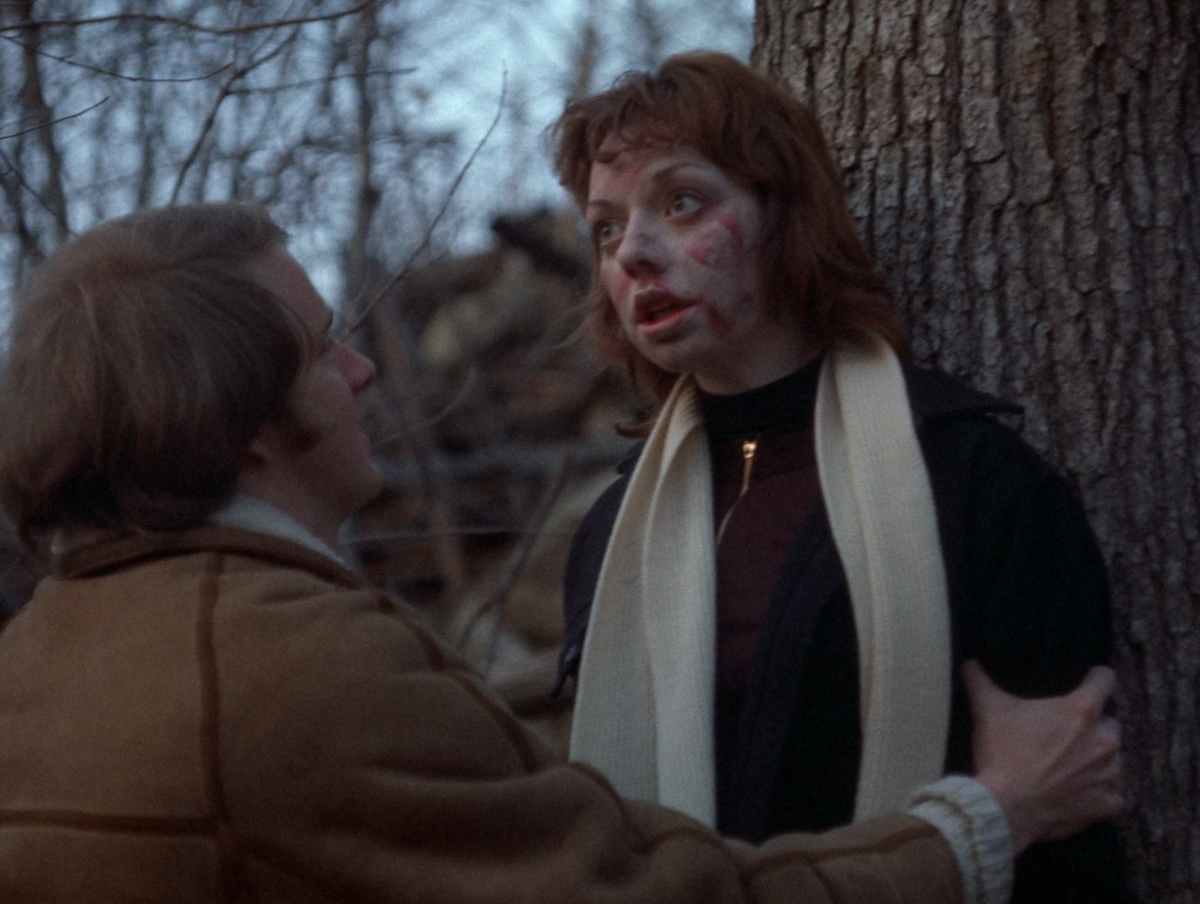
The expedition gets off to the typical start for a horror film: The students and Prell drive their flower-powered van out to the countryside where a gas station attendant warns of the dangers ahead. They cross a cordoned-off bridge and reach the home of Dr. Warner (Tawm Ellis), a friend of Prell’s who claims to have seen the beast. Warner lives alone with Laughing Crow (Ivan Agar), his mute Native American cook. Warner’s encounter is recollected as a distant sighting, during which the hillside seemed to pulse with an overwhelming heartbeat. When he spotted the yeti far off among the trees, the creature disappeared before his eyes.
The students are eventually led into the woods and killed off one by one. As Prell begins using their remains for bait, it becomes clear that Prell and Warner have a sinister reason for bringing the students into the forest in search of this elusive cryptid. When a secret society arrives in a procession of fancy black cars, one could confuse them for the rejects who didn’t get invited to Eyes Wide Shut. Sure enough, as the surviving students learn, Prell’s latest houseguests did not come for a yeti hunt, but for a very special feast.
Shriek of the Mutilated‘s production was headed by Eddie Adlum, whose previous effort behind the camera, Invasion of the Blood Farmers (1972), is another gem of upstate New York independent horror. Originally envisioned as a low-rent space invasion epic — before Adlum and his crew realized that intergalactic effects would be out of their price range — Blood Farmers found its final form as a humble small town druid saga. The film was made for very little money. The cast was paid in beer. It is far from what anyone would call a perfect film, but who wants a perfect film about druids draining a small town of its vital fluids? Invasion of the Blood Farmers is exactly what it sounds like: It’s on you to have the right expectations.
Adlum’s adventures in exploitation cinema were preceded by an unlikely career path. Born in Queens, he became an Atlantic recording artist when Ahmet Ertegun heard him and his friends — The Castle Kings — singing a song they wrote after watching a Frankenstein movie. The result was “You Can Get Him – Frankenstein,” a single Adlum shares writing credit on with Ertegun and a young Phil Spector. His life as a musician was over before it began. When the band fell through, fate led him to Cashbox Magazine, where he began a long career in coin-operated machines. He would eventually fund his films with money made from the jukebox and pinball industry and would later coin the phrase “video game” in his trade paper, RePlay. Adlum describes himself as a great salesman. He credits his short careers as a recording artist and a filmmaker to his ability to “sell shit back to the horse.” He had an enthusiasm that could earn record deals or get films off the ground without having the talent to turn in a true “quality” product. This enthusiasm was present on his film sets and certainly shows through in the earnestness of his productions.
Following right on the heels of Blood Farmers, Adlum worked with much of the same crew on Shriek of the Mutilated, including co-writer Ed Kelleher, and his editor, Michael Findlay, who would direct the film. Findlay had made a career, alongside his wife, Roberta, in the sexploitation industry. The films he wrote and directed in his early years, such as Take Me Naked (1966) and the Flesh trilogy, were far from typical, even for grimy 42nd street. Findlay, a lapsed Catholic who was rejected from seminary school, carried a lot of baggage throughout his tragically short life. His films would mix sex, fantasy, and violence, while at times demonstrating genuine artistic ambitions and a poetic sensibility. He loved film and, according to Adlum, wanted to make “real movies.” Whatever the project called for, he pulled from a dark well within for his films.
Despite the differences in their styles, when Findlay and Adlum met, they became fast friends. Both loved their alcohol, and Shriek of the Mutilated, in the words of Adlum, was written and prepared over “copious amounts of Budweiser.” Adlum’s co-writer, Kelleher, also lacked film experience. The only creative writing he had done was for the stage, which hints at why the film leans so heavily into the dialogue. Adlum believed that for a schlock movie to be successful, “every ten minutes, you need to chop someone’s face off.” Therefore, characters ramble on and on while everything is explained in long expository episodes before the writers would decide it was “time for an atrocity.” A cast was assembled and Adlum’s wife stitched together a furry white yeti suit for Eddie himself to don before the camera. They loaded up some bologna sandwiches to feed the cast and crew and Shriek of the Mutilated was ready to begin.
Of course, few independent productions are without their problems and potentials for ruin. Shriek of the Mutilated was no exception, especially for its director. The Findlays’ turbulent relationship was in a rough place as Michael was beginning work on the film. Roberta had left him and they had recently put their daughter up for adoption, a decision which Adlum says haunted Michael and led him further into his dependence on alcohol and Valium. He was a wreck in the early stages of production and Adlum wasn’t sure if he would be able to get the job done. Desperate, Adlum ushered in Roberta to shoot the movie and act as emotional support for Michael.
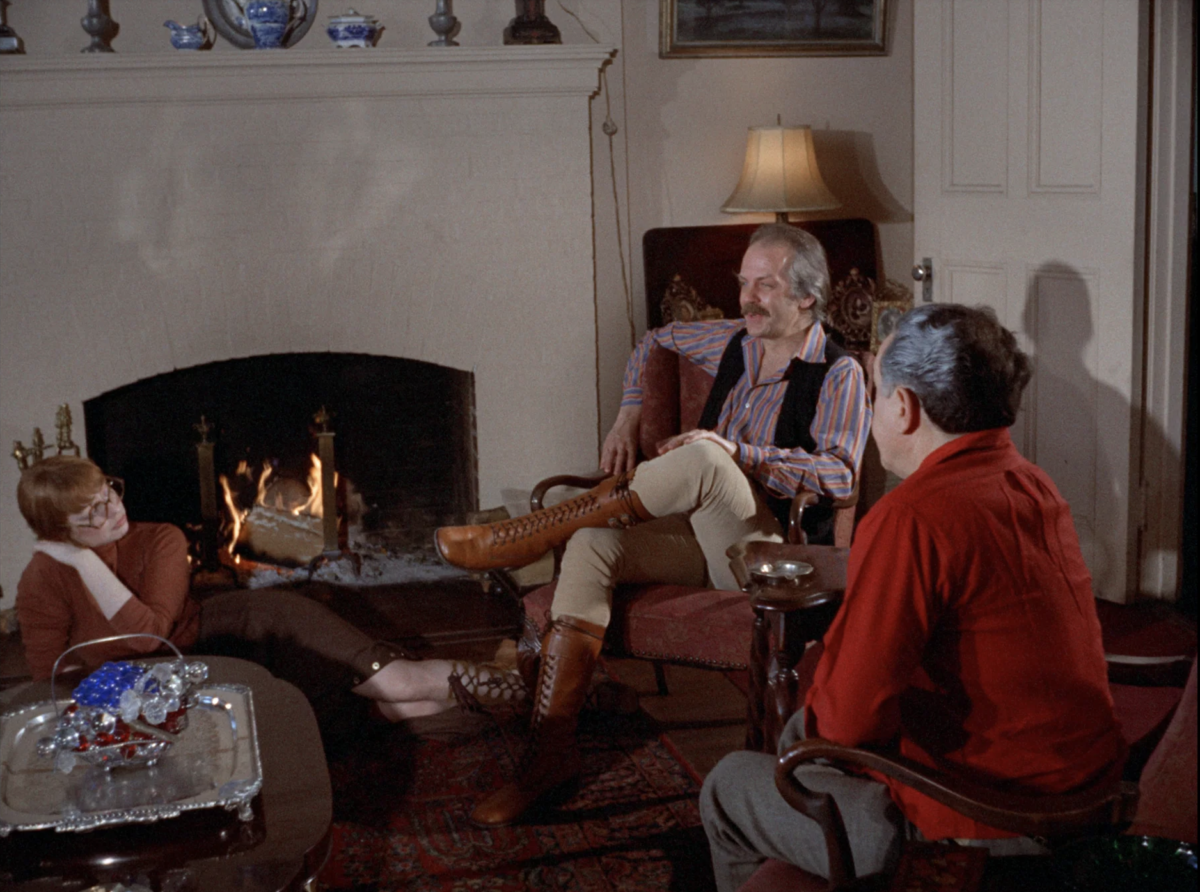
Today, Roberta claims to barely remember the film or its production. By all accounts, it was a quick and scrappy shoot. The eccentricities of its cast and crew caused memorable delays and hiccups in the production. Alan Brock, who played Dr. Prell, purported to have been a former child actor. He lived with his mother at a distance from the filming locations in the same house he was born in. Brock required rides to and from the shooting locations. He had problems with his memory, and his flubbed and forgotten lines ate up film. Money was tight. Adlum raised funds through some personal friends and contacts he had made at Cashbox. According to Roberta, money was dropped off under what she thought were shady circumstances by men in big black cars — not unlike those that arrive in the film’s finale. Even the score, a surprisingly inspired selection of classical music, including Hector Berlioz’s “Dream of a Witches’ Sabbath” long before it inspired the theme from The Shining (1980), was chosen as a sort of corner cut. Michael Findlay and Adlum apparently went into a record store and purchased cheap, imported LPs of symphonies, assuming there was no chance in hell the rights owners would ever stumble across their little movie. The scoring does give the film a sort of dimestore grandiosity, especially during the opening titles, in which fuzzy, whitewashed footage of the yeti is accompanied by the second movement of Bohuslav Martinů’s The Frescoes of Piero della Francesca.
Reviews seem to be mostly of the mind that Shriek of the Mutilated is a bit of a letdown. With a title like that, it isn’t necessarily surprising. First off, there is very little mutilation. In fact, when Roberta Findlay first heard the title, she thought it was a joke. Violent inserts had to be added to spice up the film for drive-in audiences. One of the additions was a bizarre sacrifice scene, featuring a brief cameo from Michael, that opens certain cuts of the film. The horror elements are mostly underscored with humor rather than a desire to shock. The film is more of a romp than anything. Comparisons to Scooby Doo are common and earned, and not only because the ensemble of students and their choice of vehicle come close to a spitting image of the Mystery Team. The yeti itself exudes the spirit of a high school sports mascot more than the vicious, time-jumping, white-haired sasquatch that Dr. Prell purports it to be. The film eventually makes it clear why the beast acts the way it does — in fact, much clearer than one might expect from the chaotic action of the first two acts. But despite any rounding of its edges by its third act, Shriek of the Mutilated maintains a roughness through its style and attitude. The film knows what it is and is comfortable in its own scruffy fur.
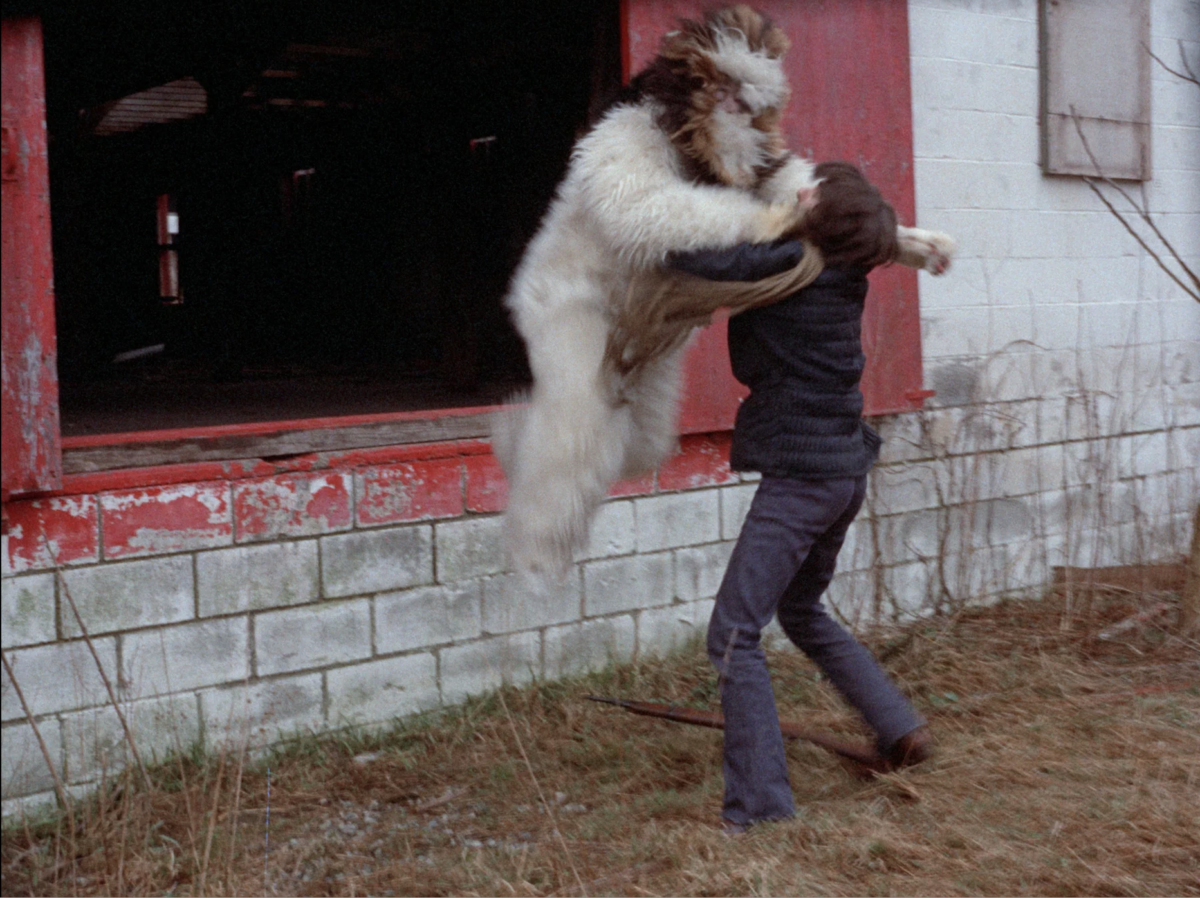
Adlum admits he and many of his collaborators had no idea how to make a movie, which Roberta Findlay backs up. They just did it and learned, as best they could, along the way. Unlike Roberta, who would make the move out of exploitation to more conventional horror productions with success, Shriek of the Mutilated was Adlum’s final film production.
While Adlum may joke about and disparage his film work, it is precisely the lack of “know-how” that makes so many of the best schlock movies worth a damn, including Shriek of the Mutilated. In that gaping void where so-called “talent” and technical ability should be, the odd and uncomfortable clashing of personalities and often discordant sensibilities can make their home. The yeti, for instance, is far from gruesome, but some of the attacks are quite jarring. Roberta Findlay apparently did everything she could to mask the hokeyness of Adlum’s yeti costume, mostly by framing the attacks in extreme close-ups and low angles to make the small-in-stature Adlum look more intimidating. For anyone who first saw the film in the diminished quality of video or cheap digital transfers before it received the 4K treatment from Vinegar Syndrome, this caused most of the yeti attacks to take on an almost disorienting blur of motion: smattered shots of victims caked in streaky red paint, screaming between tightly framed profiles of the monster’s garish red lips at the center of a fuzzy white haze. For a film that is accused of being too tame, the Yeti strikes do occur quite regularly and with some force behind them.
But it is the bizarre interlude at the Ste. Claire home that casts a palpable nastiness over the rest of the film. The scene involves the traumatized survivor of Prell’s previous yeti excursion, Spencer Ste. Claire (Tom Grail) and his wife April (Luci Brandt) when they return home following his outburst at the popcorn party. With his repressed memories of the expedition now unleashed upon his psyche, Spencer drowns himself in alcohol before abusing and slicing his wife’s throat with a butcher knife. Blood splatters between shots of Tide boxes and shattered vodka bottles in the sink. Spencer then continues his binge in the bathtub, soaking in his blood-stained clothes and downing Budweiser. April slowly crawls across the floor into the bathroom with a toaster, which she plugs in and slides into the water with her husband. He fries to death while his mouth fills with soapy bathwater.
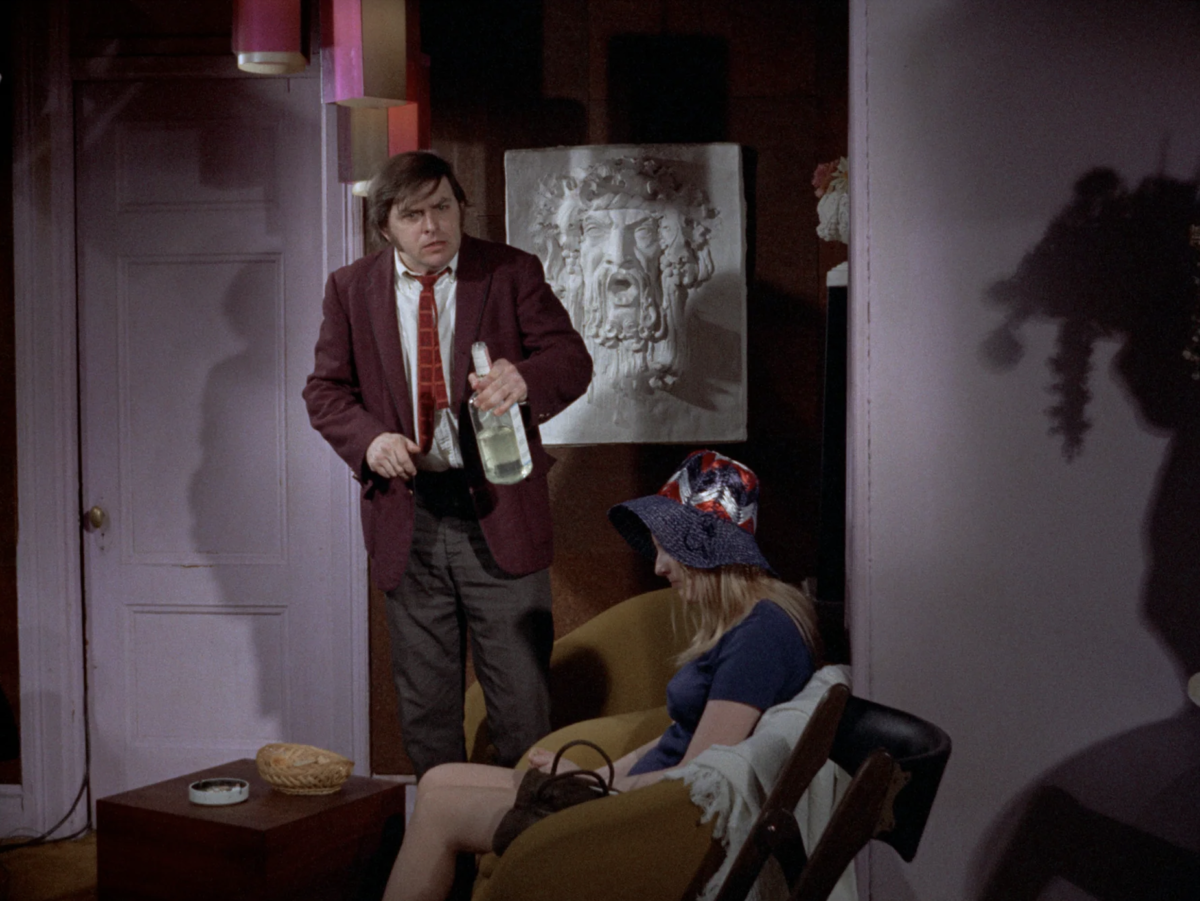
Adlum featured a somewhat similar hotel shower murder in Invasion of the Blood Farmers. Under Adlum’s direction, the scene is anything but chilling; it’s mostly a winking reference to Psycho with Adlum playing the film’s Janet Leigh. It is far from the domestic hell of the Ste. Claire’s final night together. Shriek’s double murder feels straight out of one of Michael Findlay’s roughies; It briefly shifts the film into the darkness of his past works like Take Me Naked. For Michael, this brutality wasn’t necessarily some distant make believe merely conjured for grimy entertainment. Roberta believes that filmmaking was a “catharsis” for her once-husband and that killing women was “his fantasy.” She says, “Had he not made the films, I think he would’ve done [it] for real.” Roberta mentions this in both her interview and commentary track featured on the new Blu-ray of Shriek of the Mutilated. Yet even as Michael’s films often explicitly show men erupting from twisted dreams and fantasies into real acts of violence towards women, she feels Michael was unaware of what his actual desires truly were. Roberta also expresses doubt during her commentary track over whether Michael could ever have acted out his violent desires, stating that she found him to be too much of a coward.
Others, including Adlum, describe Michael not as a coward, but as more of a sad, sensitive, and gentle giant. Both aspects come through in his films, as noted by Stephen Broomer in his essay on Take Me Naked for Art & Trash. Broomer recognizes that Take Me Naked “contains moments of extraordinary tenderness and beauty, exaggerated by cinematography in which haze and shadow and pure white forms render its erotic phenomena unreal.” It is also “a soft-core exploitation film with appeal to the darkest side of that marketplace, and in this it is lurid, even cruel.” Jetta Weinstein, in an episode of the Split Your Head podcast devoted to the Findlays, draws attention to the affection Michael’s friends and collaborators held for him, while also recognizing a sort of boyish abandon in the effort Findlay would put into his murder scenes. His early roughies feature brutal kills by electrocution and even a lobster claw. You can’t help but imagine that, while brainstorming these extravagant celluloid murders, he wasn’t wearing that same wild grin seen in his Shriek of the Mutilated cameo as the gawker at the poolside beheading.
This drive for memorable movie deaths was a foundational part of Michael’s relationship with Adlum. The two drinking buddies would often get together and imagine ways to “chop off people’s heads for $2.50” in their next picture. Adlum claims they were planning another film together after completing Shriek of the Mutilated. This next project was set to include a death by car engine fan. But when their yeti epic was finished, Adlum recognized that the final product was underwhelming. Fearing he would be left with a film in the can and no money to show for it, he sold the full rights to the first bidder willing to buy and made very little profit. This hurt Michael so badly that the pair never spoke again.
In a turn that is almost unbelievable, the death by rotating fan that Findlay and Adlum planned for their next movie would have a tragic real life mirroring in reality. On May 16, 1977, Michael Findlay was one of four killed atop New York’s Pan Am Building when a helicopter tipped over. Adlum found out through a friend. When he went looking for confirmation in the paper, he found the news to be true, though Michael’s name was spelled wrong in the story. Speaking of his friend’s violent death decades later, Adlum still breaks into tears. “He was so troubled,” says Adlum, and he never got to make the “real movies” that he dreamt of.
Much like the legacy of its director, Shriek of the Mutilated holds a strange place in the annals of exploitation cinema. Looking back now, Adlum is proud to have made a film that has been referred to as one of the worst movies ever made. He seems to recognize the humble glory in such a distinction, especially as the film has earned new life with its recent restoration. For a film with such a muddled history and reputation, the future looks bright for Shriek of the Mutilated.
Stream Shriek of the Mutilated on Amazon Prime
Purchase Shriek of the Mutilated on Blu-ray from Vinegar Syndrome or Amazon
Find the complete October Horror 2023 series here:
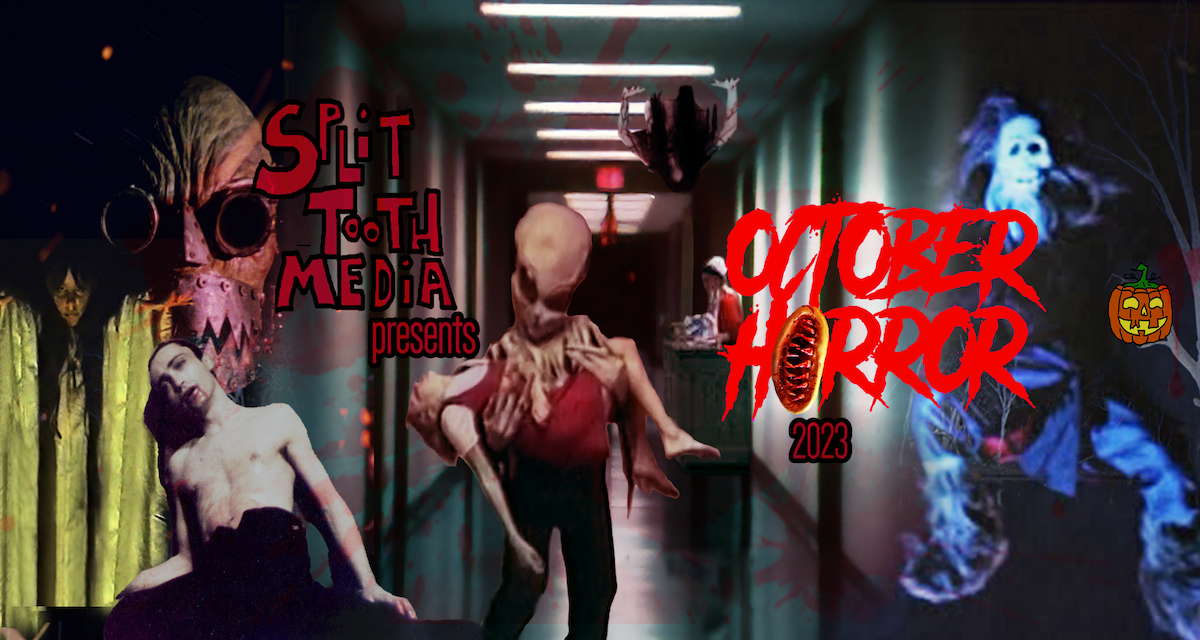
(Split Tooth may earn a commission from purchases made through affiliate links on our site.)

